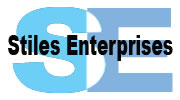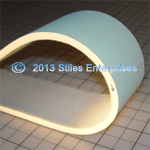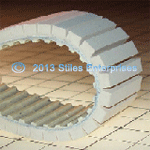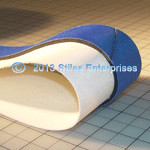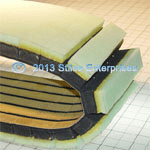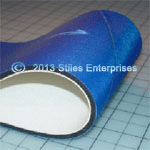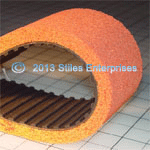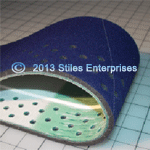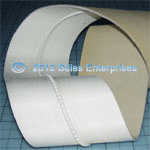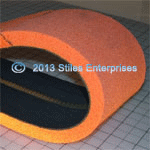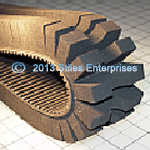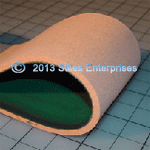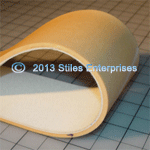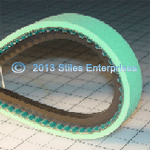
|
Applications:Base Belts:Related Links: |
Cellular Rubber Covered Belting
Stiles has been applying cellular covers to new belts and resurfacing worn belts for decades.
Although we have concentrated on the packaging industry, customers in the automotive industry, metal working industry, extrusion industry and varied other industries have come to Stiles to provide covered belt solutions for sometimes unique applications.
Specialty belting from Stiles is standard on many new machines in the packaging industry. We manufacture new and resurfaced belts for labeling machines with cellular and solid (dense) rubber . Your feed and discharge belts, roll belts, and hold down belts are items that may have originated at Stiles.
We stock materials from around the world to make our belts, and other parts from. We can add bevels, contours and release or protective coatings.
Layered construction can provide a thin layer of outer contact material bonded to a different base material. The specified base material may provide the desired deflection or cushioning, but may not give the right amount of grip, wear out to quickly, or not be resistant to other elements, such as chemicals in the operating environment. A different wear surface material can often address those other concerns.

New Belts
Stiles can add a cellular cover to almost any base belt with a flat surface . Provide us with as much information as possible about the belt and application. If available give the type of belt, belt number and material. For belting which has to be spliced endless, laced, or prepared endless, make sure to let us know whether the length is the cut length, inside length around the pulleys, or the outside length. Using length measured on the machine around the outside of covered belts is discouraged. Provide original equipment cross reference numbers if possible. Application information is very important.
Recovered Belts
Stiles resurfaces belts with cellular padding. Recovering solid covered belts is not usually cost effective. Recovered belts can give cost and delivery advantages over new belts. The best way to proceed with belts to be resurfaced is to send them to Stiles to review and quote. Be sure to include contact information with any special instructions. Not all belts are able to be recovered due to the condition of the base belt or some other variable.
Running Direction
Most cellular belts have cover splices or seams. If a belt is running bi-directional the splice selection is critical since some splices are directional by design. Custom insets and profiles should be referenced according to the running direction. For seamless covers this direction reference is not relevant for most simple profiles and steps.
Material Selection
This is another situation where application information is helpful. We can send sample cards which will aid material selection. Please review our material link. Note that if a material is discontinued we will advise on a substitute solution.
Storage And Care Of Belts
When belts are first received they should be removed immediately from the shipping container, inspected, and stored in a relaxed state free of localized stress points which can cause some materials to dent or crease.
Store away from extreme heat or direct light. To extend inventory shelf life it is suggested to protect belts in black garbage bags if "UV" resistant bags are not available.
If belts are to be hung, use a large diameter tube to hang the belts from to avoid the belt taking a set. This is not as much of a problem with solid covered belts as with cellular covered belts.
Cleaning
Do not use solvents for cleaning covered belts. Use mild detergents such as diluted dish detergent.
See Belt Care link below.
